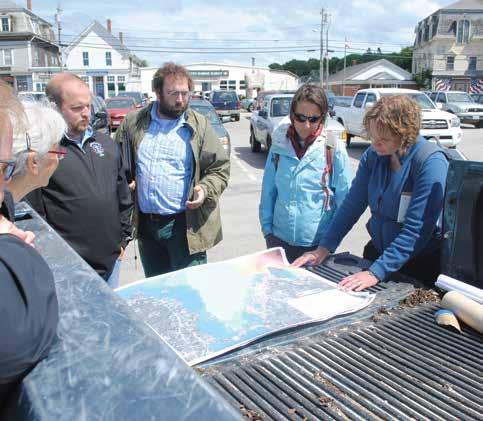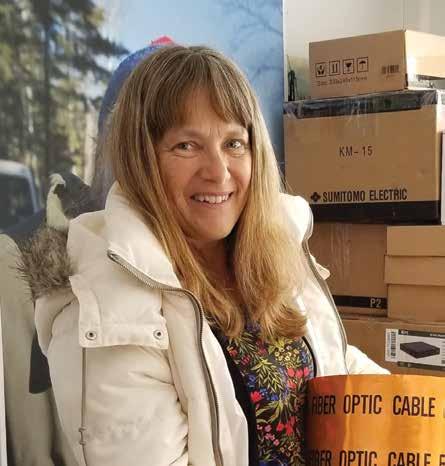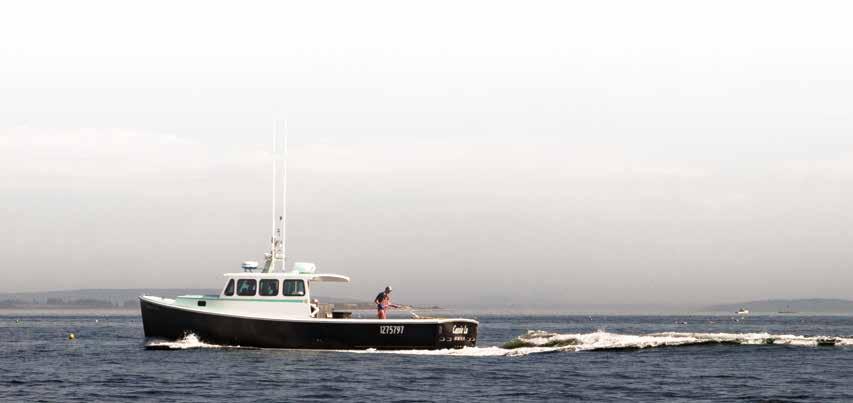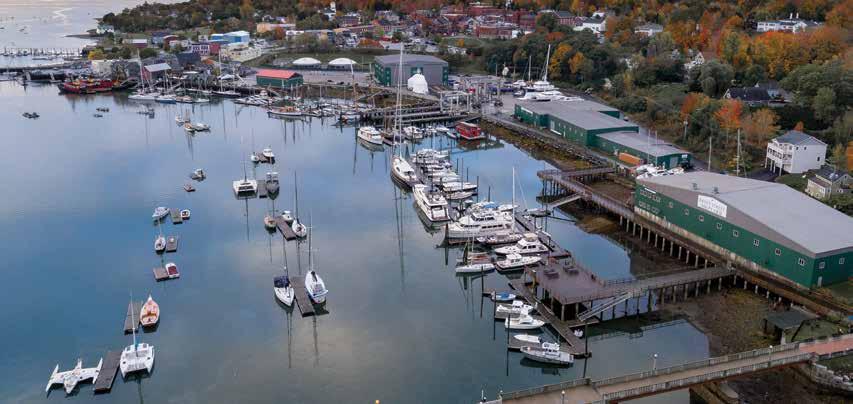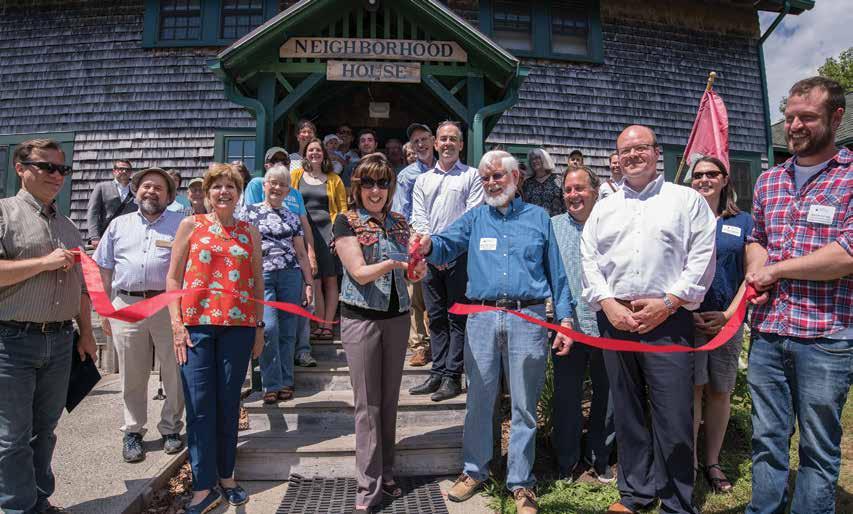
11 minute read
DATA NOTES
GENERAL INFORMATION In the United States, the U.S. Census Bureau recognizes geographic units within all counties and statistically equivalent entities known as county subdivisions. In the state of Maine, these county subdivisions are minor civil divisions, a type of county subdivision with legal boundaries and governmental or administrative functions. These data presented in this publication for ‘communities’ come from the American Community Survey (ACS) and Decennial Census which rely on these county subdivisions for the spatial analysis. The ACS uses multi-year surveys to compile enough data to improve the statistical reliability of the findings. Caution should still be exercised when taking this data as absolute due to large margins of error in communities of such small size. Some difficulties are associated with using Census data for Maine’s island communities. First, Great Diamond, Cliff, and Peaks islands are all included in the totals for Portland. Where possible, Peaks Island is broken out using Census Tract 24, Block Group 1. Cranberry Isles is a county subdivision that includes both Islesford and Great Cranberry Island, two distinct communities. This is also the case for Edmunds and Trescott townships which are combined into the East Central Washington county subdivision with other territories. All U.S. Census Bureau data are available at data.census.gov.
PAGE 2 | MAINE AT A GLANCE MAP: Population “B01003. Total population: 2018–Maine County Subdivisions.” Dataset: ACS 5-Year Estimates. STATISTICS: Median Age “S0101. Total Population by Age and Sex: 2018–State of Maine and U.S.” Dataset: ACS 5-Year Estimates. Rural “P2. Total Population, Urban and Rural: 2010–Maine County Subdivisions, State of Maine, and U.S.” Dataset: Decennial Census (SF1). BAR CHARTS: Self-Employment Income “B19053. Self-Employment Income in the Past 12 Months by Household: 2018–Maine County Subdivisions, State of Maine, Northeast Region, and U.S.” Dataset: ACS 5-Year Estimates. Median Household Income “S19101. Income in the past 12 Months by Household (in 2018 inflation adjusted dollars): 2018–Maine County Subdivisions, State of Maine, Northeast Region, and U.S.” Dataset: ACS 5-Year Estimates.
Advertisement
PAGES 4-5 | BROADBAND | ECONOMIC FEASIBILITY MAP: The map displays a point density analysis (not speed or coverage), an analysis that shows density of premises along the road network. It is dependent on the known relationship between premise density and broadband speeds. This relationship exists for the simple reason of the spatial pattern of human settlement. Dense areas have access to higher speeds for three reasons: 1. Dense areas are often in the urban centers and are therefore closer to the source. 2. Density makes it more cost effective to build out the necessary infrastructure for the broadband system and therefore internet service providers are more likely to build and continually upgrade a system. 3. Federal grants can only be awarded to places where the density meets a minimum level, meaning areas that are more rural are unlikely to be eligible for broadband grants. DATA LAYERS: Point density analysis based on 1. Maine Geolibrary. Maine E911 Roads. Emergency Services Communication Bureau: State of Maine, 2019. https://gis.maine.gov/arcgis/rest/services/Location/ Maine_E911_Addresses_Roads_PSAP/MapServer/2. 2. Maine Geolibrary. Maine E911 Addresses. Emergency Services Communication Bureau: State of Maine, 2019. https://gis.maine.gov/arcgis/rest/services/Location/ Maine_E911_Addresses_Roads_PSAP/MapServer/1. All accessed 1 November 2019. PIE CHARTS: Premise Density Across Maine calculated using county subdivisions and point density analysis described above.
PAGES 6-7 | BROADBAND | CONNECTING COMMUNITIES INSET MAPS: Based on same point density analysis described above. PAGES 8-9 | TRANSPORTATION | SEA LEVEL RISE VULNERABILITY MAP: Percent of miles of roads and addresses inaccessible at two feet of projected sea level rise compiled by The Nature Conservancy of Maine for the Coastal Risk Explorer tool with Bowdoin College, the Maine Geological Survey, and Blue Sky Planning. MAP INSET: Deer Isle-Stonington inset map based on 1. Maine Geolibrary. Maine E911 Roads. Emergency Services Communication Bureau: State of Maine, 2019. https://gis.maine.gov/arcgis/rest/services/ Location/Maine_E911_Addresses_Roads_PSAP/MapServer/2. 2. Maine Geolibrary. Maine E911 Addresses. Emergency Services Communication Bureau: State of Maine, 2019. https://gis.maine.gov/arcgis/rest/services/ Location/Maine_E911_Addresses_Roads_PSAP/MapServer/1. Accessed 1 November 2019. STATISTICS: Global average sea level rise Fourth National Climate Assessment 2018, Chapter 2: Our Changing Climate. Key Message 4. https://nca2018.globalchange.gov/chapter/2/. Accessed 31 December 2019.
PAGES 10-11 | TRANSPORTATION | FINANCING THE RESPONSE DATA POINTS: Based on analysis from “The Cost of Sea Level Rise: Economic Impact Analysis,” a 2019 study commissioned by the Island Institute. Results of the study can be found here: Vinalhaven - https:// arcg.is/1f8T9L.
PAGES 12-13 | TRANSPORTATION | CO₂ EMISSIONS MAP: Gately, C., L.R. Hutyra, and I.S. Wing. 2019. DARTE Annual On-road CO₂ Emissions on a 1-km Grid, Conterminous USA, V2, 1980-2017. ORNL DAAC, Oak Ridge, Tennessee, USA. https://doi.org/10.3334/ ORNLDAAC/1735. Accessed 31 December 2019. MAP INSETS: Maine State Ferry Service Maine Office of GIS. Maine Department of Transportation Public Roads (Ferry Routes). https:// www.maine.gov/megis/catalog/metadata/medotpubrds.html. Accessed 1 November 2019. Casco Bay Lines Adapted from Casco Bay Lines Islands Map https://www.cascobaylines.com/islands/. Accessed 31 December 2019. STATISTICS: CBL total emissions Casco Bay Lines. 1 November 2017. “Fueled by French Fries: Casco Bay Lines Runs on Biodiesel” [Blog post]. https://www.cascobaylines.com/blog/fueled-french-fries-casco-bay-linesruns-biodiesel/. Accessed 8 January 2018; correspondence with Hank Berg of Casco Bay Lines. MSFS total emissions Number presented by Maine Department of Transportation. October 2019. Maine State Ferry Service Advisory Board Meeting, Rockland, Maine. State of Maine total emissions “State Carbon Dioxide Emissions Data, 2017.” U.S. Energy Information Administration–EIA Independent Statistics and Analysis, https://www.eia.gov/environment/emissions/state/. Accessed 31 December 2019. Percent rural VMT from “Fact #902: December 7, 2015 Rural versus Urban Vehicle Miles of Travel by State.” Office of Energy Efficiency and Renewable Energy: Vehicle Technologies Office. https://www.energy. gov/eere/vehicles/fact-902-december-7-2015-rural-versus-urban-vehiclemiles-travel-state. Accessed 10 January 2020. Carbon dioxide emissions coefficients Greenhouse Gas Protocol 2017, https://ghgprotocol.org/sites/ default/files/Emission_Factors_from_Cross_Sector_Tools_March_2017. xlsx Diesel fuel 10.16kg CO₂/gallon; B20 Biodiesel 8.10442 kg CO₂/gallon; B20 Biodiesel 1.892 kg CO₂/gallon from biomass fuel; B20 Biodiesel portion of CO₂ emissions avoided is 2.03kg CO₂/gallon. Rural “P2. Total Population, Urban and Rural: 2010–Maine County Subdivisions, State of Maine, and U.S.” Dataset: Decennial Census (SF1). PIE CHARTS: “State Carbon Dioxide Emissions Data, 2017.” U.S. Energy Information Administration–EIA Independent Statistics and Analysis, https://www.eia.gov/environment/emissions/state/. Accessed 31 December 2019.
PAGES 14-15 | ENERGY | HOME HEATING MAP: Heat pumps Efficiency Maine residential heat pump incentives program, FY2014-FY2019. Number of Housing Units “DP04. Selected Housing Characteristics (Total Occupied Housing Units): 2018–Maine County Subdivisions.” Dataset: ACS 5-Year Estimates. Limitation Values of percent of heat pump coverage may appear inflated because a housing unit could have up to two heat pumps installed using Efficiency Maine incentives.
PAGES 16-17 | TRADE | DOMESTIC CONNECTIVITY MAP: Traded Industries are defined and categorized by Delgada et al. “Categorization of Traded and Local Industries in the US Economy.” 2015. US Clusters Project. https://www.clustermapping.us/content/clustermapping-methodology. Data “S2404. Industry by Sex for the Full-Time, YearRound Civilian Employed Population age 16 and Over: 2018. Maine County Subdivisions.” Dataset: ACS 5-Year Estimates. The location quotient (LQ) is a method of quantifying how concentrated a particular traded industry is in a community as compared to the state as a whole. It is calculated by dividing the proportion of individuals working in an industry in a given community by the statewide average for that industry. Values above 1 indicate a community has a greater relative proportion in a certain industry compared to the state which can be interpreted as an indication that it is serving more than its local population. For example, an LQ value of 1.5 can be interpreted as a community having a 50% greater proportion of individuals in a given industry than the state average. The export industry associated with each coastal community was identified as the export industry with the highest LQ.
PAGES 18-19 | TRADE | INTERNATIONAL CONNECTIVITY MAP AND BAR CHART: Export data are from the U.S. Census Bureau using the USA Trade® Online tool. https://usatrade.census.gov/.Harmonized System Port-Level Data was averaged over the five-year period 2014-2018 to smooth out single year anomalies and to provide a more general picture of export trade through Maine’s coastal ports. Export values represent the amount of products that flow through Maine ports on their way to other countries, regardless of where the product originated. As such, this data will differ from other export data series based on product origination. The reason the fleets were picked was partially due to limited data availability. The lobster fleet was not shown, because the entire fleet has not been required to regularly report vessel locations.
PAGES 26-27 | WORKING WATERFRONTS | PROTECTIONS MAP: Working Waterfront Access Protection Program (WWAPP) Project sites and acres from Land for Maine’s Future. Working Waterfront Access Protection Program, 2019. https://www.maine.gov/dacf/lmf/ docs/2008-June2019-LMF-WWF-projects-completed.pdf. In the summer of 2019, six new properties were selected for the Land for Maine’s Future Working Waterfront Access Protection Program, but the funds are not awarded until after an appraisal and proper due diligence is successfully completed. These properties are not shown on the map. Current Land Use for Working Waterfront State of Maine, Department of Administrative and Financial Services, Maine Revenue Services. “Municipal Valuation Return Statistical Summary Report 2017.” https://www.maine.gov/ revenue/propertytax/municipalservices/statisticalsummary.htm. Accessed 31 December 2019. Data cleaned and joined with county subdivisions. U.S. Army Corp of Engineers Dredging locations: USACE, New England District. “Maine Navigation Projects.” https://www.nae.usace.army.mil/ Missions/Navigation/Maine-Projects/. Accessed 31 December 2019. STATISTICS: Totals of acres, parcels, and communities in the Current Land Use Program are from the Municipal Valuation Return Statistical Summary Report 2017 (listed above). In the WWAPP, “Sustaining Maine’s Working Waterfront.” The Working Waterfront, 14 August 2019, http:// www.islandinstitute.org/working-waterfront/sustaining-maines-workingwaterfront. Accessed 14 January 2020; total acres from project sites list from Land for Maine’s Future (listed above). Percent of communities with a protection based on spatial analysis of each of the above programs’ locations and the 120 county subdivisions of coastal Maine. CREDIT: Additional support provided by Caitlin Cleaver.
PAGES 20-21 | TRADE | LOBSTER IMPORTS AND EXPORTS MAP: Top three lobster ports in Maine based on landings value. Values from Maine Department of Marine Resources Lobster Landings Viewer. https://maine.maps.arcgis.com/apps/opsdashboard/index.html#/ aad15e3248d44555a11d01ba4bbc51f8. Accessed 31 December 2019. PIE CHART: National Oceanic and Atmospheric Administration National Marine Fisheries Service 2018. Fisheries of the United States 2017. Silver Spring, MD: Office of Science and Technology. https://www.fisheries.noaa. gov/webdam/download/92995934. Accessed 9 January 2020. BAR CHART: Total U.S. lobster exports: U.S. Census Bureau using the USA Trade® Online tool. https://usatrade.census.gov/. State Export Data (Origin of Movements). The state export data reflects only the value of products that originate or have a final destination in the US. Dates: July 2017–June 2018; July 2018–June 2019. Note: Several regions were omitted from the bar charts. These are Australia and Oceania, Africa, and South America. These ‘Other Countries’ represent $6.5 million from July 2017-June 2018 and $9.1 million from July 2018-June 2019. FLOW DIAGRAM: Maine and Canada trade: U.S. Census Bureau using the USA Trade® Online tool. https://usatrade.census.gov/. Harmonized System Port-Level Data. The port-level data reflects the value of products that flow through Maine ports, even if their origin or final destination is not Maine. Dates: July 2018–June 2019. CREDIT: Annie Tselikis, Executive Director of Maine Lobster Dealers’ Association, and Emily Lane, International Sales Manager at Luke’s Lobster, provided insight into the international lobster trade and helped in the creation of the visualization that captured a complicated topic. Photo by Jeff Roberts.
PAGES 22-23 | WORKING WATERFRONTS | OCEAN TRAFFIC MAPS: All datasets are from the Northeast Ocean Data Portal https:// www.northeastoceandata.org/. 1. Vehicle Monitoring System Vessel Activity of the: Multi-Species (Groundfish) Fleet, 2015-2016; Pelagics (Herring, Mackerel, Squid) Fleet, 2015-2016. 2. Marine Transportation Commercial Traffic Vessel Traffic Counts of Tug-Tow, Tanker, Cargo, and Commercial Passenger Fleets, 2017. 3. Recreational Boating is based on the SeaPlan 2012 Northeast Recreational Boater Survey. PAGES 28-29 | CIVIC INFRASTRUCTURE | NONPROFITS MAP: Data from United States Internal Revenue Services, Charities and Nonprofits. “Exempt Organizations Business Master File Extract (EO BMF).” 2019. https://www.irs.gov/charities-non-profits/exemptorganizations-business-master-file-extract-eo-bmf and United States Internal Revenue Services, Charities and Nonprofits. “Statistics of Income Tax Stats-Annual Extract of Tax-Exempt Organization Financial Data.” 2018. https://www.irs.gov/statistics/soi-tax-stats-annual-extract-of-taxexempt-organization-financial-data. Accessed 31 October 2019. Analysis Only organizations filing Form 990 include the number of employees in the Statistics of Income Tax Stats File. Organizations that file 990s are larger organizations that are not private foundations. Churches, while tax exempt, are not required to file Form 990, although some do. Employee counts were totaled based on the city in the address line. These totals were joined with the county subdivisions and mapped. The data was cleaned for exceptionally large nonprofit employers who may act as a headquarters for employees out of state. For example, Jackson Laboratories employs people in multiple states and so the number was adjusted down to reflect only the employees working in Bar Harbor. STATISTICS: Hours and volunteers from the Corporation for National and Community Service, “Maine Highlights, 2018.” https://www. nationalservice.gov/serve/via/states/maine. Accessed 9 January 2020. PIE CHART: Nonprofit Organizations in Maine Nonprofit organizations filings indicate what the organization identifies as its primary exempt activity classified by the National Taxonomy of Exempt Entities (NTEE) codes. The NTEE was formally adopted in 1995, but organizations determined exempt before 1995 retain their Activity Codes as this form of identification. Where the NTEE code was blank for organizations, the Activity Code was used. These primary exempt activities were categorized and the total number of nonprofits in each category were used to calculate the percent of nonprofit organizations in Maine by the various activities. BAR CHART: State rankings by volunteerism from the Corporation for National and Community Service, Serve Your Community, “Volunteering in America, Rankings.” 2018. https://www.nationalservice. gov/serve/via/rankings. Accessed 31 December 2019. CREDIT: Additional support provided by Caitlin Cleaver.

